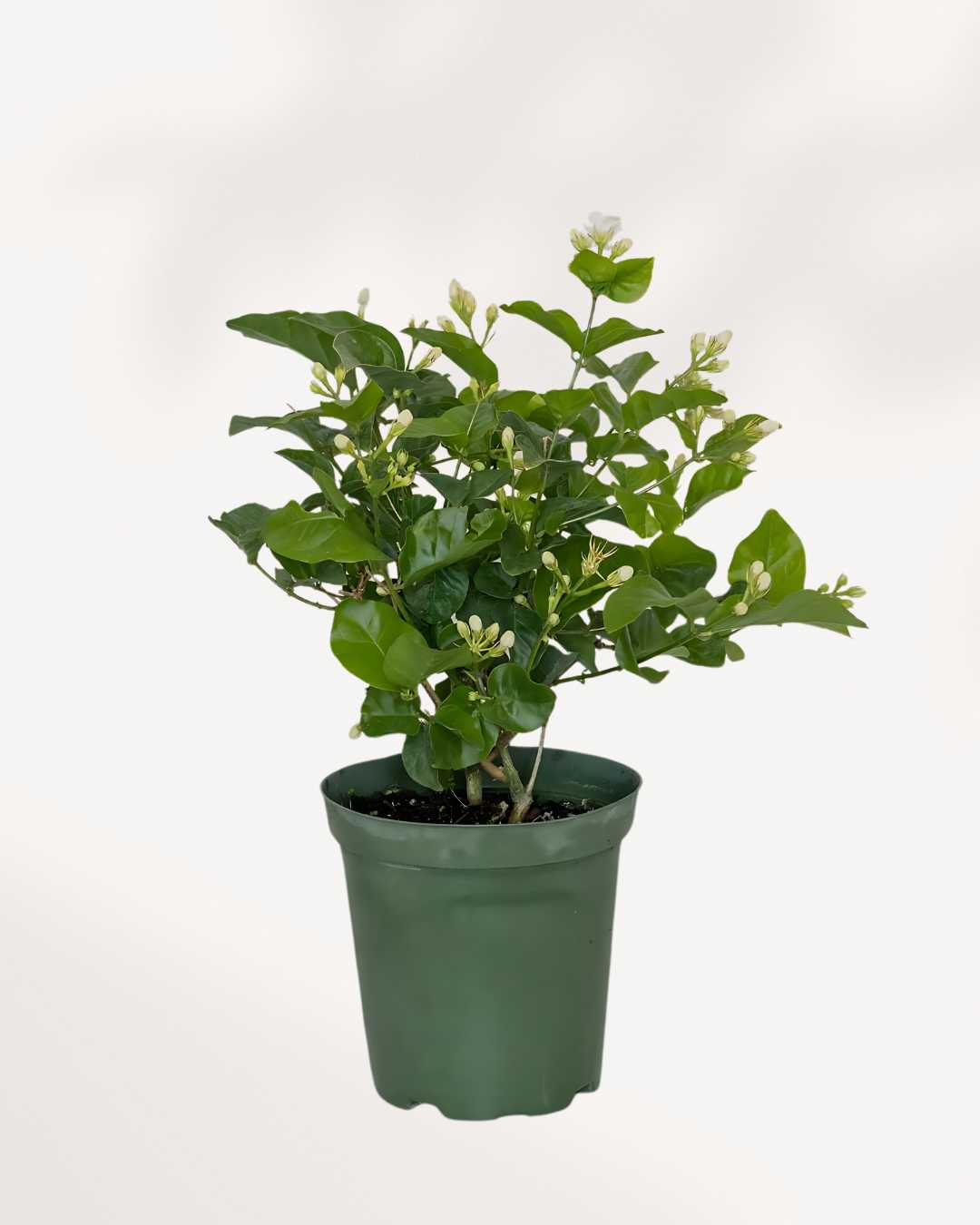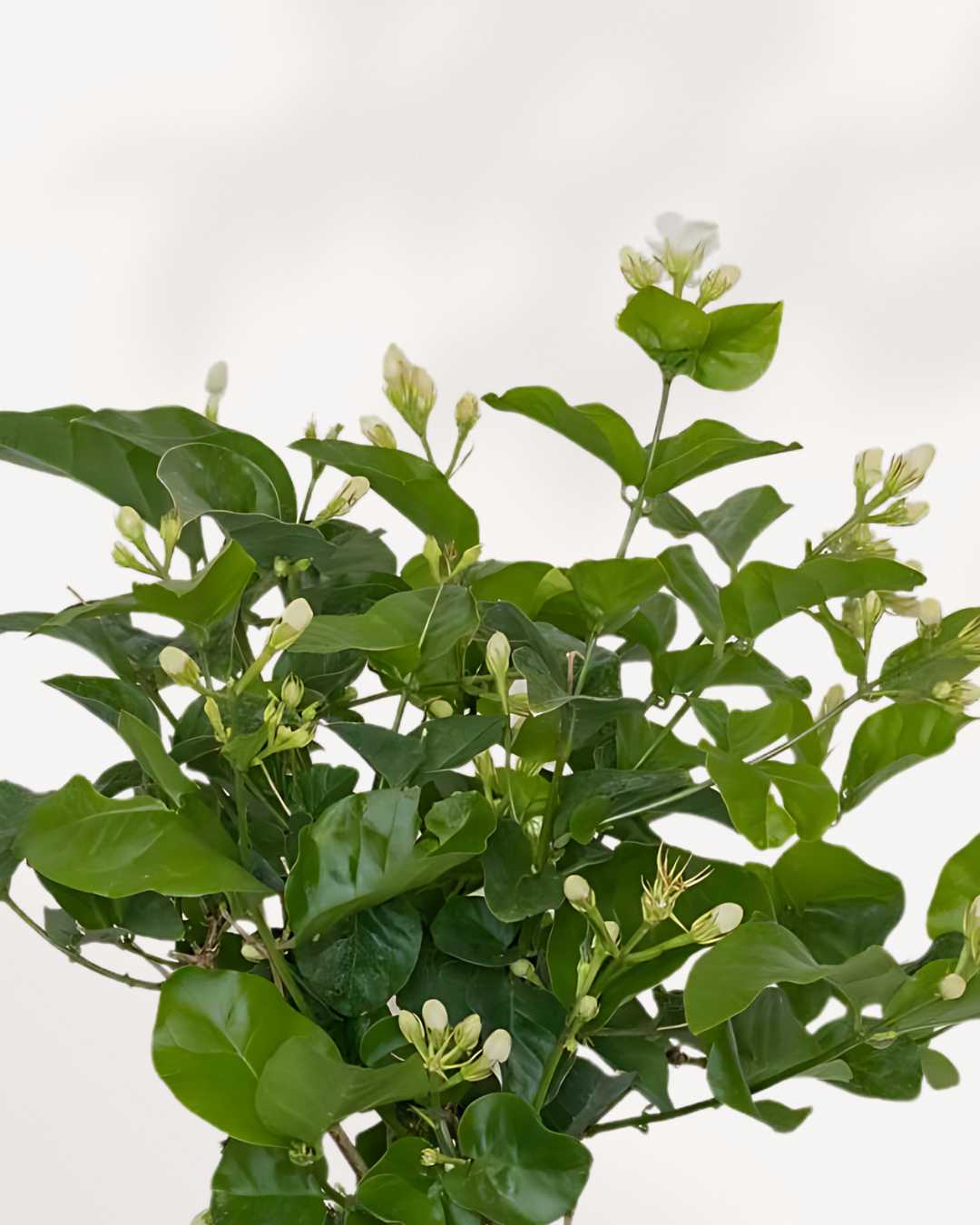Couldn't load pickup availability
Jasmine Sambac: Fragrant Elegance in Every Bloom
The Jasmine Sambac (Jasminum sambac), also known as Arabian Jasmine, is a timeless classic loved for its intensely fragrant white blooms. Native to tropical Asia, this evergreen flowering shrub symbolizes purity and love, often used in perfumes, teas, and traditional ceremonies. Perfect for indoor spaces with bright light or sunny balconies, it brings a sense of calm, beauty, and gentle nostalgia wherever it grows.
Why Jasmine Sambac Deserves a Spot in Your Home
🌼 Heavenly Fragrance
Each bloom fills your room with a rich, sweet scent that lingers into the evening, especially after sunset.
☀️ Loves the Sun
Thrives in bright light and warmth, making it perfect for sunny windows, patios, or south-facing rooms.
🌿 Evergreen & Long Blooming
Produces lush green foliage and blooms year-round under the right conditions, offering beauty in every season.
💚 Symbol of Positivity
In many cultures, Jasmine Sambac represents grace and purity, uplifting the mood and energy of any space.
All the Details You Need to Know
The Story Behind This Plant
Jasmine Sambac originates from Southeast Asia and is cherished across the world for its intoxicating aroma. In India, it’s known as “Mogra,” and in the Philippines, it’s the national flower called “Sampaguita.” Whether grown indoors or outdoors, it’s a plant that connects you to tradition, serenity, and sensory beauty.
How to Keep It Happy
- Light: Prefers full sun to bright indirect light. At least 4-6 hours of sunlight daily ensures steady blooming.
- Water: Keep soil evenly moist but not soggy. Allow the top inch to dry before watering again.
- Humidity: Loves humidity. Mist regularly or place near a humidifier, especially during dry indoor seasons.
- Soil: Well-draining potting mix enriched with organic matter or perlite for airflow.
- Temperature: Thrives in 18–30°C (65–86°F). Protect from cold drafts and frost.
- Feeding: Feed every 2-3 weeks in spring and summer with a balanced fertilizer to encourage continuous blooms.
Pest Prevention & Care Tips
Healthy Jasmine plants rarely face issues, but occasional pests can appear in dry or low-light conditions. Regularly inspect leaves and maintain good airflow.
Popular Jasmine Varieties
- Night Blooming Jasmine – Famous for its powerful evening scent that fills the air after dusk.
- Stephanotis Madagascar Jasmine – Elegant vines with pure white waxy blooms, often used in weddings.
- Star Jasmine – Glossy foliage and star-shaped blossoms perfect for trellises and balconies.
Frequently Asked Questions by Plant Parents
-
Q: Why isn’t my Jasmine Sambac blooming?
A: It usually needs more sunlight or consistent feeding. Try moving it to a brighter spot and fertilize during growing months.
-
Q: Can Jasmine Sambac grow indoors year-round?
A: Yes, as long as it gets plenty of bright light and warmth. A south-facing window or grow light works best.
-
Q: How can I make my Jasmine bushier?
A: Prune lightly after flowering to encourage new branches and fuller growth.
Ready to Welcome the Fragrance of Jasmine Sambac?
Bring timeless elegance and heavenly scent into your space with Jasmine Sambac. Order yours today and let every bloom fill your home with peace and beauty.
How to take care of the Jasmine Sambac
Light: Bright
Light: Bright
Sun: Direct & Indirect
Sun: Direct & Indirect
Water: When half dry
Water: When half dry
Humidity: Medium
Humidity: Medium
Pet Friendly: Caution
Pet Friendly: Caution
Pro Tip
Pro Tip
Delivery Policy for Plant Condition
Delivery Policy for Plant Condition
"I have only received part of my order. What to do?
No worries if you've only got part of your order! Our plants come from different nurseries and might arrive in separate shipments, typically 1-2 days apart. It's all part of ensuring your green friends reach you in top-notch condition!
If you do not receive the remaining packages within 48 hours contact support at info@mygreenscape.ca
What is the Life Time Support?
Absolutely! Lifetime support means you can count on us whenever you have questions or uncertainties about your plant. Whether you're puzzled by its behavior or just want to ensure it's thriving, we're here for you. Connect with us on Instagram @mygreenscapeto or shoot us an email at support@mygreenscape.ca.
When it comes to our guarantee for plants shipped with standard or express, rest assured that we offer a 30-day happy healthy plant guarantee on all such shipments. This ensures that your plants are covered for 30 days after delivery, giving you peace of mind regarding their condition. If you have any concerns within this period, feel free to reach out to us for assistance.
For further details, please visit our Local Delivery, Store Pickup, Standard Shipping Guide Page.
What to expect
What to expect
Your plant will arrive in a standard nursery pot, typically 0.5" - 1" smaller than the stated size to seamlessly fit into your chosen decorative pot. Washable Paper Planter Bags are available for separate purchase.
Just like nature intended, each plant is unique, showcasing natural variations in size, shape, and characteristics. Our commitment is to deliver a plant that closely resembles the one featured on our website, matching your chosen size, and with the potential to thrive happily in your home.
Frequently Asked Questions
Frequently Asked Questions
Certainly! If you're pondering about ordering plants online, you're not alone. We've compiled the most frequently asked questions. Check out our FAQ section here for quick answers! Happy planting!
Plant & Pot Size Chart
Plant & Pot Size Chart
Choosing the right pot size for your plants can be a daunting task, especially if you're new to gardening. But fear not! Our pot sizes chart can help you find the perfect match for your plants, ensuring they have enough space to grow and thrive. With our guide, you'll be able to confidently choose the right pot size and plant variety for your gardening needs.
Plant Pot Size Guide.

| Extra Small | 7-10 cm | 2.5 - 3 inches |
| Small | 11-12 cm | 3.5 - 4 inches |
| Medium | 14-17 cm | 5 - 6 inches |
| Large | 19-21 cm | 8 - 10 inches |
| Extra Large | 24-27 cm | 12 - 14 inches |
All sizes are specified in product details.
Your Complete Guide to Pot Sizes: What Size Should You Choose?

When selecting a pot for your plant, it's important to find the right size. But with all the different options out there, how do you know which one is best? We're here to help!
MyGreenscape's pot sizes chart is a great resource for finding your perfect fit. Our easy-to-read chart takes out all the guesswork and helps you quickly choose the right size for your plant.
Smaller pots are best for seedlings or small plants just starting out. These tend to be shallow but wide, allowing enough room for the roots of the young plant but not too much where they get overcrowded. Medium-sized pots are ideal when your plant has grown from its infancy and is ready for more space. These are deeper and wider than small pots, so that it can accommodate larger root systems - making sure your plant gets enough nourishment while still giving it breathing room. Large pots are top choice if you have an established plant in need of lots of space - think trees and large shrubs! The spacious depth and width allow plenty of room for deep root systems without struggling for air or light.
No matter what size you choose, MyGreenscape has got you covered, with our pot sizes chart guaranteeing you find the perfect fit every time!
Winter Shipping Protection
Winter Shipping Protection
We take extra care with each package during the colder months. For destinations experiencing cold weather, we provide insulated packaging and heat packs as needed to protect your plants from freezing temperatures. With Winter Shipping Protection, your plants are equipped to arrive safe and sound, even in winter’s chill.
Care Guide
Care Guide
Explore essential care tips. check out our Comprehensive Resource for Indoor Plant Care.


WATERING MADE EASY
Check soil moisture before watering and use a potting mix that drains well. It’s the secret to healthy, happy plants!
Hear From Happy Plant Parents.
Who have brought Mygreenscape plants into their homes.














